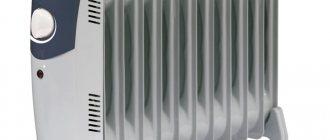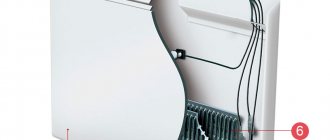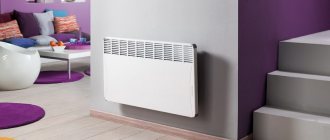Heating in the house is perhaps the most important issue in winter. If the home is cold, then all other problems fade into the background. In general, the heat in the house should be provided by the main centralized heating, but it often happens that it is not enough. It is in such cases that additional heating devices come to the rescue, of which there are quite a few types and models on the modern market. Ceramic heaters stand out noticeably among them - efficient, fairly affordable and actively conquering the market. What are their features?
Ceramic heaters for home: features
So, what exactly is a ceramic home heater, how much heat does it produce and what is the operating principle of its heating element? First of all, you should understand the types of this device, and there are three of them on sale.
This:
- Wall heaters;
- Floor models;
- Mobile systems.
The first type of heater is the most popular - you hang it on the wall in the right place and it heats, for example, a work area. Or you can place such a heater in the nursery near the child’s bed.
Floor-standing models are less convenient to use, as they take up space on the floor where you could walk or place furniture. However, they are the most effective, since warm air rises from the bottom up, thereby heating the entire room.
Mobile systems can be placed anywhere - they are compact, but not so powerful. For example, if the room is cold but you need to be in it, you can place a heater at your feet while reading or working at the computer. This way you will receive a reliable additional heat source.
Room area and device power
First of all, you need to decide what area you need to heat.
The device of what power you need depends on this. How to calculate this power? There is a simple and reliable formula that is suitable for all types of heaters except infrared.
For every square meter of a room with a standard ceiling height, it is advisable to have at least 100W of power.
For an infrared heater, there is an unspoken rule that 100W per 1m2 of area is its maximum power, not its minimum.
To the resulting value you need to add 200W for each window.
It follows from this that, for example, one room with an area of 13 m2 will be quite effectively heated by a model of 1.3 kW + 0.2 kW = 1.5 kW.
What if your ceiling height is 3m or more? Then use a slightly different calculation. Multiply the total area of the room by the actual ceiling height and divide this value by an average factor of 30. Next, also add 0.2 kW per window.
Of course, according to calculations, you can choose a less powerful device, especially for apartments where there is already main heating (central or boiler).
But given the constant heat loss and the fact that it will take longer to warm up the room, it’s better to play it safe. Devices with several heating stages are ideal. The more there are, the better.
Moreover, when the set temperature is reached, the built-in thermostat must turn off the device, no matter what level it is at. And when it decreases, turn it on again. Thereby significantly saving energy.
And also, a more powerful heater, when operated in “half” mode, will serve you much longer than its counterparts selected back to back.
Ceramic wall heaters: selection criteria
As already mentioned, wall-mounted models of ceramic heaters are the most popular on the market today. They look like a panel that is mounted on the wall near the workplace, bed, sofa or other area where people often spend time.
A ceramic heater of this type can easily be confused with an air conditioner; usually such panels are made in white, and the system operates and is controlled by a remote control.
When choosing a wall heater for your home, you should give preference to models with an automatic rotation function; they distribute the air in the room more evenly. Considering that you can’t just move a wall heater, this is very important.
Working principle of ceramic heating element
The heater has ceramic plates that are blown with hot air, causing them to warm up slowly. After the plates of the heating element warm up, they accumulate heat for a long time and even after turning off the device they will still give off heat for some time and actively warm the room. This is a big advantage compared to other types of heaters.
The principle of operation does not involve oxygen intake, since the heater has a fan that supplies air to the plates. As a result, the air in the room does not dry out, and heating is carried out gradually.
Roughly speaking, a ceramic heater is like a fan that blows hot air through ceramic plates. Thanks to this scheme, not just warm, but hot air is introduced into the room, which, for example, heat fans cannot do.
Nikaten
A distinctive feature of heaters of this brand is their insignificant thickness, which does not exceed the corresponding parameter of ordinary porcelain tiles.
Inside this fairly thin plate there is a heating element. Each panel has special holes for convection and fastening.
The advantage of such heaters is the ability to combine infrared and convection heating, which contributes to significant energy savings.
Hybrid heaters
Along with classic ceramic heaters, there are also so-called hybrid panels on the market.
A quartz hybrid is a split system in which two types of heating elements are involved in the heating process.
So, for example, at the initial stage of heating, warm air can be released into the room according to the principle of a fan heater, then, when the ceramic plates of the heater are heated properly, the second type of heating is switched on, when the ceramic releases heat; this is a less fast, but longer-lasting principle of operation. Hybrid panels are usually more expensive, but at the same time they are much more efficient in operation.
Ceramic heaters "Tepla Khata"
If you want to provide heating for an entire house with thermal panels, then of course such a task will require serious expenses. The only option for reasonable savings in this case is the purchase of domestic thermal panels, for example, produced.
The advantages of thermal panels are obvious:
- They not only provide uniform heating of the house, but also create sound insulation in the house;
- They are resistant to mold formation;
- The service life of the panels is about 20 years.
It is believed that proper installation of thermal panels can reduce heating costs by almost 2 times.
Ceramic heaters Dimol
One of the leaders in the market for the production of ceramic heaters is Dimol. Dimol heaters are distinguished by an attractive aesthetic appearance that fits perfectly into the interior, compact dimensions and, most importantly, high operating efficiency.
Dimol are wall heaters that can simply be plugged in and will quickly heat up a small room.
Dimol is often not used as the main source of heating due to its low power, but as an additional source it is used everywhere. As the main source of heating, the device can cope with a room of about 10-12 square meters. meters, for example in the toilet. It is effective to use dimol as an additional source in rooms with an area of 16-20 square meters. meters.
Pros and cons of ceramic-based heaters
Uniform heat distribution is the main advantage of a ceramic heater. Unlike traditional heat sources, the distribution of warm air flows throughout the room in the case of a ceramic heater occurs smoothly, slowly and as evenly as possible. This is not a fan heater that blows air in one direction - a ceramic heater heats all surrounding objects.
In addition, ceramic heating includes the following advantages:
- There are no drafts, the air does not dry out. In fact, these are two advantages related to the state of the air; it does not dry out, so it is very comfortable to be in a room with a heater. On the other hand, the air masses are distributed very slowly, without creating a draft, as with other types of heating systems.
- High efficiency. If you use a ceramic heater as an addition to the main heating system, it will have extremely high efficiency, at 80% or even higher. This is due to the fact that it warms objects around it, so if you place it near the bed, the heat will only go to the bed, which is what you actually need. Why heat furniture or walls if you want to warm yourself?
- Safety. Ceramic heaters cannot flare up or catch fire; they do not have open heating elements that can get burned. They release warm air into the room, while remaining just warm on the outside. In addition, ceramic heaters absolutely meet fire safety requirements and can be safely left on even in a child’s room.
- Practicality. Thanks to the features of the heating element, ceramics, the heaters are extremely compact. They do not take up extra space in the room, especially if they are mounted on the wall.
Ceramic-based heaters also have some disadvantages.
This:
- Price. The first and most significant disadvantage is the fairly high cost of ceramic heaters. If you want to save money, then buying such a heater will clearly not be the best decision. However, if you want to invest in a quality heater with many important benefits, then cost will not be a barrier for you.
- Long warm-up. Unlike infrared heaters, which will begin to heat up objects around you within 30 seconds, ceramics will take time to warm up. You will have to wait, but the wait will be rewarded with all the benefits that these heaters have.
Control system
In stores you can buy heaters with two types of control:
mechanical
electronic
Models with mechanical control are the simplest and cheapest. However, they have a whole bunch of shortcomings that not everyone is aware of.
firstly limited functionality
In addition, during long-term use they are more susceptible to wear. This means they will fail earlier than electronic ones.
The error when setting the set temperature can reach several degrees!
When turning on and off automatically they click quite loudly
And this happens constantly every 10-20 minutes. So you won’t want to leave such a unit in the bedroom overnight.
The temperature in expensive models can be set with an accuracy of a few tenths of a degree!
However, do not forget that electronic ones are often equipped with a backlight, which may not turn off completely.
And this can be quite irritating, especially if you are used to falling asleep in complete darkness.
There is a natural desire to cover such a screen with something. And here the most important thing is not to forget the basic safety rules for heaters:
do not dry anything on them and do not cover the radiator openings
Do not place near curtains or furniture
Therefore, check the lighting, as they say, without leaving the cash register.
How a ceramic heater works (video)
Well, ceramic heaters are a very interesting choice if you need additional heating during the heating season. Ceramic heaters work in the following way: warm air is passed through ceramic plates, which gradually heats them up; as a result, after a while the room begins to fill with warm, not dry air. The heaters are compact, they specifically heat the area they are aimed at, but they have one significant drawback - high cost. Ceramic heaters come in three types - wall-mounted, floor-mounted and mobile. The most popular are wall-mounted, as they do not take up extra space in the room, while providing excellent additional heating for rooms up to 20-25 square meters. meters. As the main heating, an average ceramic heater can provide heat only to a small room of about 10 square meters. meters. If the price of the device is not the main thing for you, then ceramics will be an excellent choice, but if you want to save money, you will have to settle on a more traditional choice - oil or infrared systems.
Comments
0 Anya 02/18/2018 21:01 An excellent way to insulate a room, now the range is simply huge, you can find both large and very small appliances.
The price depends on many factors, but you can find a very affordable option. Quote
Update list of comments RSS feed of comments for this entry
Hybrid
The Hybrid brand represents a ceramic infrared heater that can operate on a hybrid principle: convection and infrared radiation.
The advantages of heaters of this brand include the following:
- Up to 20% energy savings when using an electric ceramic heater.
- Automatic control.
- High degree of security.
- Improved design.
- Quiet operation.
- Ionization and air humidification.
The onset of cold weather forces homeowners to use additional heating devices. Therefore, to create a comfortable and cozy environment in your home, you need to choose the right ceramic heater.
Useful tips Connection diagrams Principles of operation of devices Main concepts Meters from Energomer Precautions Incandescent lamps Video instructions for the master Testing with a multimeter











